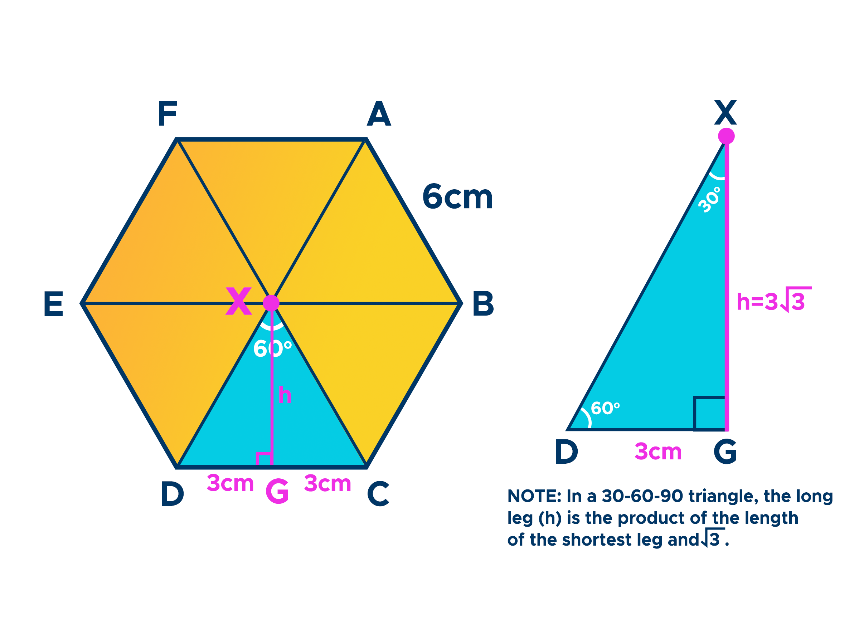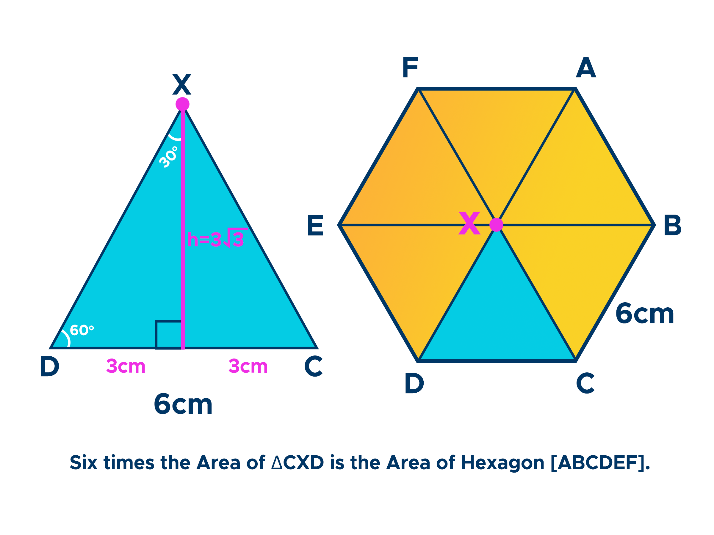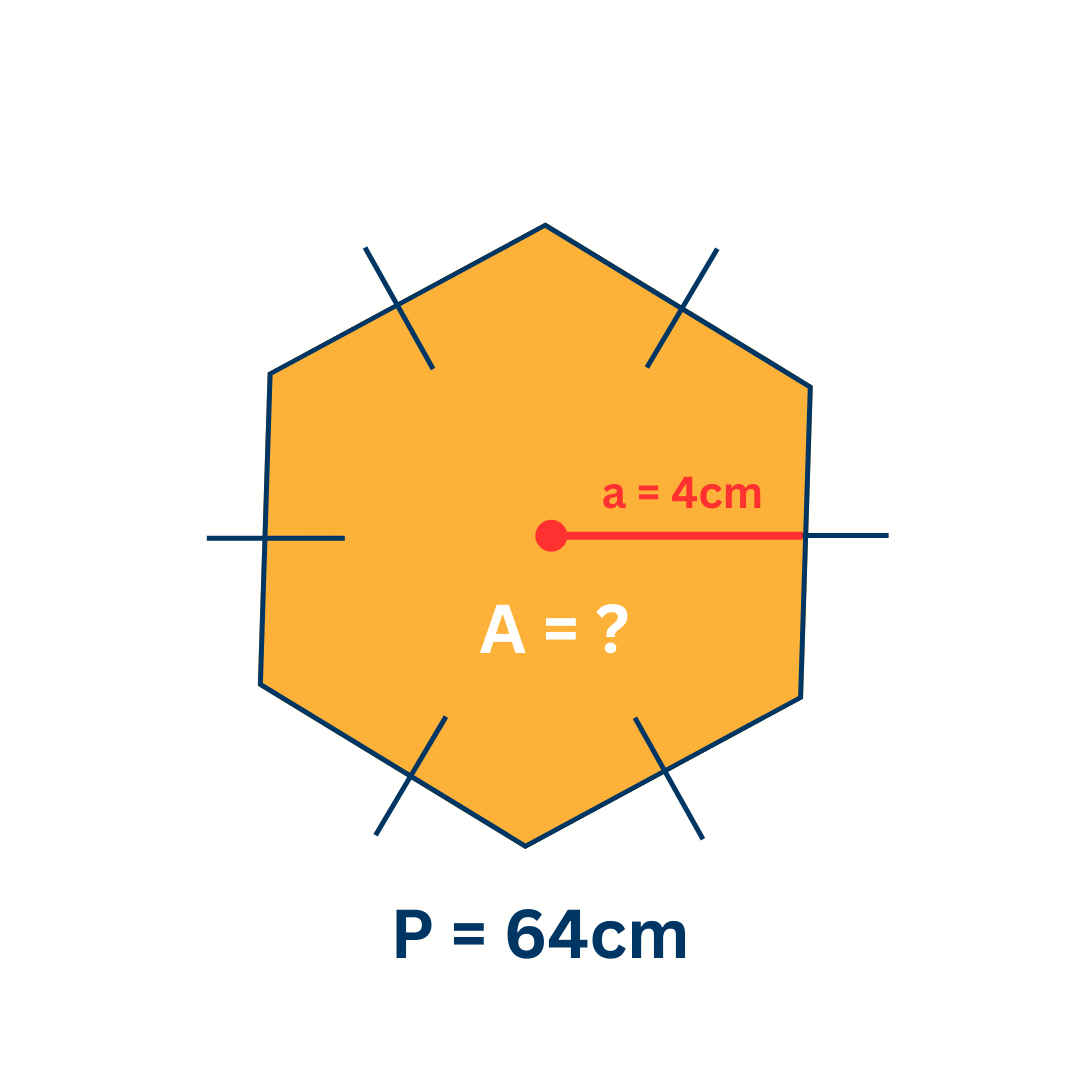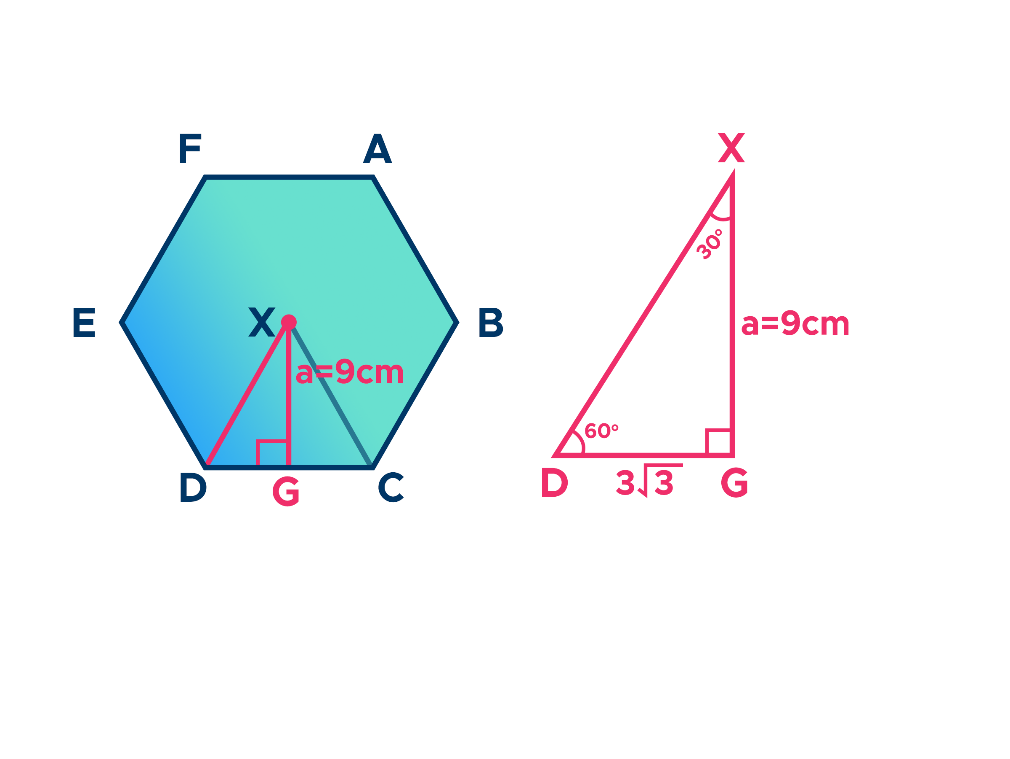Let’s learn how to find the area of a hexagon.
What is a Hexagon?
A hexagon is a six-sided flat shape whose sum of interior angles is always 720°. If the hexagon has six equal angles and sides, it’s a regular hexagon. Otherwise, it’s an irregular hexagon. Regular polygons have apothem – the perpendicular distance from the hexagon’s center to the midpoint of one of its bases.
Remember that all hexagons only have straight sides; no curves. Examples of hexagonal objects are honeycombs, metal nuts and bolts, and tabletops.

There are several ways to compute the area of a regular hexagon. Let’s discuss some of them.
Related Reading: Area of a Trapezoid – Formula & Examples
Method #1: Splitting the regular hexagon into six (6) congruent and equilateral triangles.
The general formula for this is expressed by the equation:
A = [(3√3) / 2] • s2
where A = Area of a hexagon; s = side length of the hexagon
Here’s how to use Method #1:
- Split the hexagon into six triangles that have equal sides and angles.
- Find the area of one triangle.
- Multiply the area of that triangle by six to find the hexagon’s area.
Example Using Method #1:
Let’s work on this hexagon with 6cm side.

One revolution means 360°, so diagonally splitting the hexagon gives us six triangles measuring 60° each (360 ÷ 6). Our goal is to find the area of one triangle first. For this example, let’s work on ∆CXD whose base is 6cm and angles are 60°. Take these steps to determine its area:
Step 1. Bisect ∆CXD and name the new point G. Now we have ∆DXG, a special right triangle having a 30-60-90 angle and a base of 3cm (6cm÷2). Special right triangles have a side-length ratio of 1:2:√3.

Step 2. Find the value of h or the length of ∆DXG’s longest side by following the ratio above. This will give us 3√3.
Step 3. We know that the value of h is also the height of ∆CXD, which is what we need to compute its area.

Step 4. Now, substitute the measurements (b = 6, h = 3√3) into the formula for a triangle’s area:
A = (bh) / 2. Remember that the h is also the apothem of the regular hexagon.
A∆CXD = (6)(3√3) / 2
=18√3 / 2
A∆CXD = 9√3cm2
The area of ∆CXD is 9√3cm2.
Step 5. Multiply the area of ∆CXD by 6 to get the hexagon’s area.
A⬡ABCDEF = 6 (9√3)
A⬡ABCDEF = 54√3cm2
Therefore, the area of the hexagon is 54√3cm2.
Method #2: Calculating using the regular hexagon’s perimeter and apothem
Use this formula to find the area of a hexagon using its apothem and perimeter:
A = (1 / 2) P • a
where P = Perimeter of the hexagon; a = the apothem.
Example Using Method #2:
Find the area of this hexagon with 64cm perimeter and 4cm apothem.

Plug the measurements into the formula, then simplify. Don’t forget to include the unit.
A = (1 / 2) P • a
= (1 / 2) 64 • 4
=32 • 4
A = 128cm2
Therefore, the area of the hexagon is 128cm2.
Method #3: Calculating with the given apothem
What if you’re only given the apothem?
Example Using Method #3:
Find the area of this hexagon with 9cm apothem.

Step 1. Since the apothem is also the height of the special right triangle ∆DXG, find the length of its base (shortest leg) through dividing the apothem by 3 and multiplying their quotient by √3.
Base∆DXG = (9 / 3) √3 = 3√3
Step 2. Multiply the base of ∆DXG by 2 to get the base length of ∆DXC.
Base∆DXC = 2 (3√3) = 6√3
Step 3. Find the area of ∆DXC using its base and given apothem (height).
A = (bh) / 2
A∆DXC = (6√3)(9) / 2
= 54√3 / 2
A∆DXC = 27 3 cm2
Step 4. Multiply the area of A∆DXC by 6 to find the hexagon’s area.
A⬡ABCDEF = 6 (27√3)
A⬡ABCDEF = 162√3 cm2
Therefore, the area of the hexagon is 162√3cm2.
Practice Finding the Area of a Hexagon:
#1. Find the area of a regular hexagon with an apothem of 6cm and side length of 9cm.
Finding the Area of a Hexagon Practice Problem #1 – SOLUTION:
Step 1. First, compute the perimeter using the side length.
A hexagon’s perimeter is the product of 6 and its side length:
P = 6s
= 6 (9)
P = 54cm
Step 2. Plug the apothem (a) and perimeter (P) into the formula, then simplify.
A = (1 / 2) P • a
= (1 / 2) 54 • 6
= 27 • 6
A = 162cm2
Therefore, the perimeter of the hexagon is 54cm and its area is 162cm2.
#2. Find the perimeter and area of a regular hexagon whose side length is 8cm.
Finding the Area of a Hexagon Practice Problem #2 – SOLUTION:
Step 1. Find the perimeter by multiplying the side length by 6.
P = 6s
= 6 (8cm)
P = 48cm
Step 2. Compute the area by substituting the given side length into the formula:
A = [(3√3 ) / 2] • s2
= [(3√3 ) / 2] • 82
A = [(3√3 ) / 2] • 64
= (32) 3√3
A = 96√3cm2
Therefore, the perimeter of the hexagon is 48cm and its area is 96√3cm2.
Thank you for reading. We hope it’s effective! Always feel free to revisit this page if you ever have any questions about the area of a hexagon.
Check out some of our other blog posts or invest in your future with one of our self-study courses!



